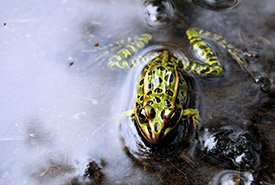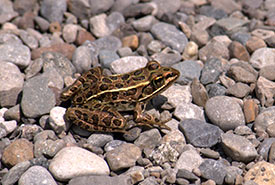Cave Pasture: A hoppy haven

Northern leopard frog (Photo by Sean Feagan/NCC staff)
As the 2023 communications and engagement intern with the Nature Conservancy of Canada (NCC) in Saskatchewan, I get to showcase different species and conservation properties that NCC is taking care of. The Cave Pasture property is the most recent addition to NCC’s portfolio of conservation lands in Saskatchewan, and it hosts a particular frog species that I’d like to share a little about.
Cave Pasture is adjacent to the city of Swift Current, and features 286 hectares of grasslands, wetlands and riparian areas, providing habitat for many species. It’s also a haven for five different at-risk species in Canada. Loggerhead shrike, Sprague’s pipit, long-billed curlew, lesser yellowlegs and northern leopard frog are all listed under Canada’s Species at Risk Act and were found on the Cave Pasture property this spring and summer.
Northern leopard frog has been assessed by the Committee on the Status of Endangered Wildlife in Canada as being of special concern. These frogs are extremely sensitive and changes or loss to even one of the three types of habitats they need can be detrimental. Separate habitats are used for overwintering, breeding and summer foraging. An overwintering site will be any body of water that doesn't freeze completely to the bottom and is well oxygenated, such as streams, rivers, lakes or deep ponds. Breeding sites include marshes, wetlands, lakes, ponds and sometimes slow-moving streams. In summer, the frogs occupy habitats like upland meadows, native prairie and riparian areas as long as these environments hold enough moisture or have a body of water nearby. They also prefer areas with shorter vegetation (less than 30 centimetres tall) so that they can move through it easily.

Northern leopard frog (Photo by Sean Feagan/NCC staff)
Northern leopard frogs head to their overwintering sites in the fall when the temperature falls below 2 C and emerge in early spring after the ice has melted and the temperatures rise to 7 C or warmer. They begin breeding as early as mid-April and will continue until the end of June if the conditions are right.
Female northern leopard frogs mate only once and lay their eggs on vegetation in shallow water. They can lay up to 7,000 eggs, but 3,500 is a typical clutch size. Once fertilized, the eggs hatch in nine to 14 days, depending on the temperature of the water. The tadpoles are small and slender, measuring around eight millimetres long. They take between 60 to 90 days to finish their metamorphosis into frogs, with less than 10 per cent surviving to become frogs. Of those that live past the tadpole stage, only 40 per cent will survive to see the next spring.
Several threats contribute to this low survival rate. Pesticides, diseases and habitat loss are all contributors. Grazing livestock must also be managed appropriately to minimize potential impacts on northern leopard frogs, including contamination of surface water, increased erosion and disruption of egg masses. Exclusion fencing within areas of potential habitat for northern leopard frogs, paired with off-site watering troughs, can help keep livestock away from these areas and minimize potential impacts.
Avoiding using pesticides and herbicides around areas of standing water and conserving existing habitat can help maintain and increase the population as well. These are just a few of the beneficial management practices that both landowners and conservation groups can use to co-exist with northern leopard frogs.

